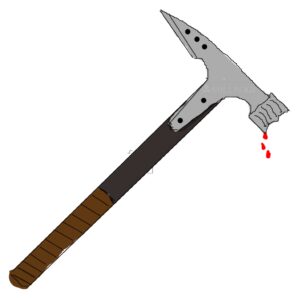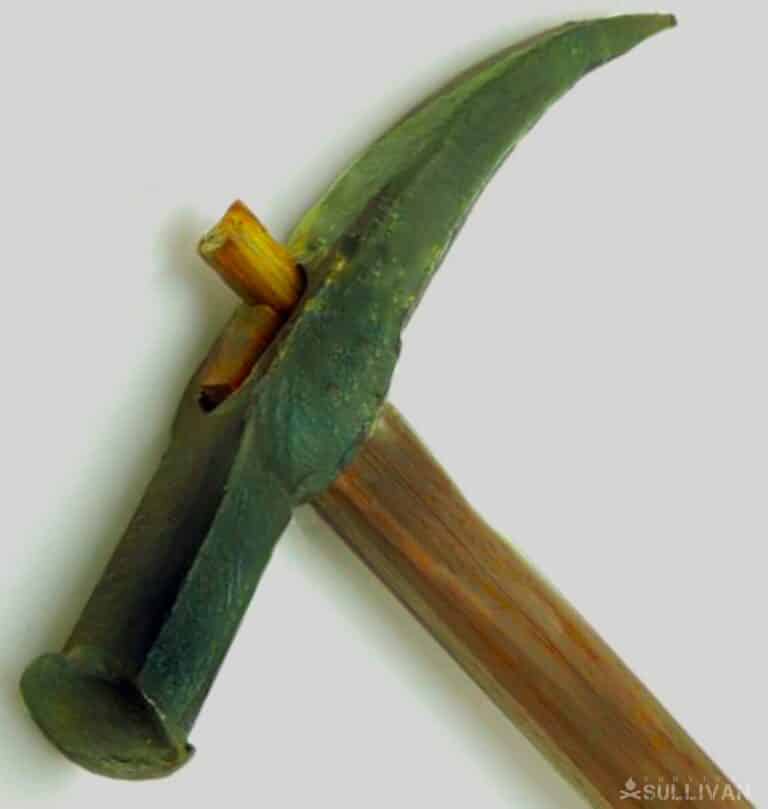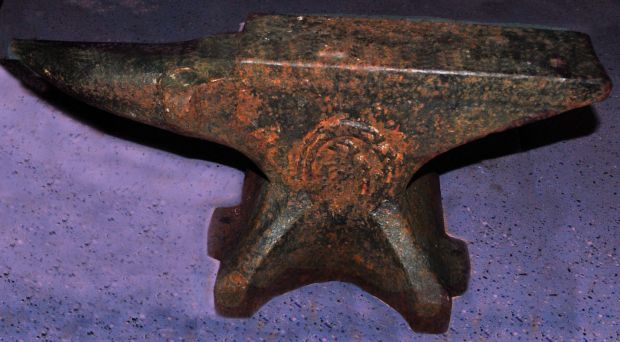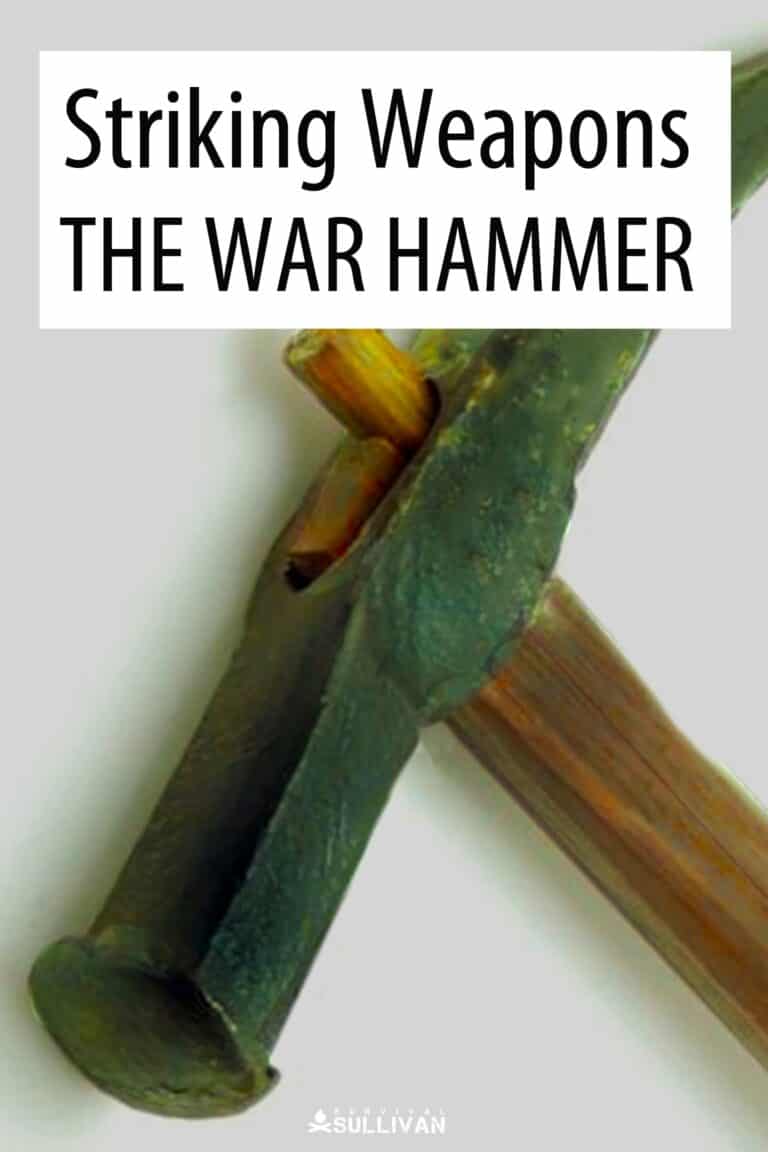I love blades, swords, knives, axes, hatchets, and tomahawks. I also love striking weapons like maces, war hammers, clubs, and the morning star (like the one pictured below), just anything medieval weapon really.
These are the most common names we know them by, but there are literally hundreds of forms of these types of weapons by various name. But I have a special fondness for war hammers.

The war hammer is a simple weapon, and being little more than a chunk of shaped iron or steel perched atop a typically wooden haft.
Strikes with a war hammer are devastating, and though they are often thought of as anti-armor weapons employed on medieval battlefields, they were more of a multipurpose solution to close quarters combat, capable of enhancing grappling techniques, disarming and even bringing down cavalry by tangling up the reins of the rider or legging the horse.
Although far from common today, war hammers are seeing something of a renaissance in certain circles, both as tactical battlefield implements and as weapons of defense.
Today in this article we will be exploring the war hammer as a historical weapon, as a concept and potentially as a useful tool in your own arsenal to help you better master an increasingly hostile world.
Table of Contents
Modern Versions of Ancient Weapons
Today, there are many manufacturers, both large scale and boutique, that produce ancient weapons like swords, spears, Shields and of course war hammers.
These reproductions fall into one of several categories, with the vast majority being replicas for display or stage usage, well a few are sturdy, high quality reproductions of ancient patterns using modern materials and manufacturing methods. Despite their vintage looks, these weapons are indeed battle ready.
The last category, and perhaps the one that will be most appealing to our readers, is a modernized version of an ancient weapon.
These weapons usually benefit from the very best in materials and our greatly improved knowledge of ergonomics and human engineering to exceed the durability and performance of their historical counterparts in every, single way. If an ancient weapon, made to the same standards today properly, is still devastating how much better might an updated version be?
That is a question we will answer in part throughout the remainder of this article. Suffice it to say that improved metallurgy, non-slip grips, virtually invincible construction and optimized head geometry means that a modern war hammer is a ferocious weapon indeed.
That being said, I still like those types of weapons. I see modern versions of them that I think are as good as, if not better than, the ancient ones. You can go online and buy fantasy weapons that look cool, that look menacing and everything. But those aren’t really real, usable weapons.
There are several that are sold intended to be used as a weapon that are of fair to high quality.
The War Hammer
Historical war hammers were typically found in two varieties. A long-handled variety fit neatly into the category of pole weapon, with handles between five and six feet long, perhaps longer in the case of some variations like the Lucerne hammer.
Shorter war hammers had handles that were comparable to a mace or hatchet, anywhere from 2 to 3 ft long. In either case, the head of the war hammer was small, usually far smaller than is often depicted in sensational media.
The head, though, was typically set up for effectiveness against armor, with either a flat face or one with prongs or crenellations that would help focus the impact of a blow and prevent it from skidding off of smooth plate armor.
Opposite the head was a spike, or beak, that while commonly thought was employed for anti-armor usage in actuality they struggled against sturdy plate armor especially that comprised of hardened steel.
Against armor invariably the striking face was used to dent and crumble the armor or transmit the substantial force of the blow through the armor to the person wearing it, often inflicting lethal or debilitating injuries.
The spike, however, was effective against softer forms of armor to say nothing of hardened bodily structures like the skull.
The spike was also something of a multi-purpose option in combat, used to easily grapple an opponent’s weapon or shield, tie up the reins of a horse or directly Target the legs of a horse to bring the rider crashing to the ground. This was often the preferred method for dealing with a mounted, armored Knight.
Other particular variations of war hammers are known as mauls, being also long-handled hammers but once with heads they could potentially be made of wood or lead and were typically oversized compared to a traditional war hammer. Like their war hammer cousins, a maul might have a spear like beak opposite the striking face.
So now that we have learned what we need to know about the concept and design of a war hammer, we need to figure out if they still have a place in the modern arsenal.
After all, many ancient weapons remain just as viable and just as useful today, particularly knives and short swords in the form of machetes and similar cutting implements.
Bows are another ancient weapon that has persisted since time immemorial. Some have returned to battlefields and such abundance that they have become ubiquitous, like the tomahawk.
Perhaps the war hammer is ready for a similar comeback.
Does the War Hammer Have a Place in the Modern Arsenal?
Determining whether or not the war hammer has a place in the modern arsenal, and particularly in the hands of a prepper, can only be accomplished by assessment of the context in which it will be used and then comparing it against other, competing options.
First things first, a war hammer is a melee weapon, one suitable and capable only in the closest and most vicious fighting.
Out of all the ancient weapons that one might choose, it is the shorter varieties that remain the most viable and useful today, mostly owing to their portability and ease of use.
Long-handled weapons like the spear and other pole arms were much of the time the kings of the battlefield but they are at their best when used in large formations, not in one-on-one fights or when surrounded by a mob.
Considered in this way, in all probability it will be a short handled war hammer that will serve as our candidate, and the one we will analyze going forward.
Now, let us compare to other close quarters weapons that would commonly be employed for self-defense, particularly self-defense in a societal collapse type of scenario that is increasingly likely to occur.
Typical implements you could expect to be used for melee fighting are knives, machetes and similar implements, hatchets, axes and even swords.
Compared to a knife, machete or hatchet a war hammer likely has Superior reach and does not rely whatsoever on edge alignment to do damage.
Simply impacting the stout, steel head against the target, even if alignment is not perfect, is enough to inflict substantial injuries, and a good shot from the strike face or the vicious Spike will do terrific damage.
Hatchets and axes share this sort of advantage, whereas even a glancing blow or a hit without the edge aligned is still an impact from a strong piece of Steel moving at high speed, and compared to the war hammer most axes will have slightly better reach.
However, compared to any of the above weapons except perhaps the machete the war hammer is less likely to become tangled up in the target, accepting perhaps the instance of the spike being wound up or tied up in heavy webbing, canvas or leather.
On impact from a war hammer’s strikeface can certainly split someone open but primarily inflicts damage through blunt force trauma with no penetration required. Similarly, the spike, if properly designed, is unlikely to embed itself or be “fishhooked” inside the target, making withdrawal for follow-up strikes easy.
A skilled user will be able to make excellent use of that spike, however, for tying up an opponent’s weapon, grappling, pulling and other tasks that can provide a significant advantage. This is something that other melee weapons, save perhaps hatchets and axes, cannot replicate.
One thing to consider when assessing a war hammer as a primary melee weapon is that it must strike the target solidly to do substantial damage, and preferably strike the torso or the head.
Sticking a shot against an extended limb with a war hammer is not easy, and furthermore blunt force weapons rely on substantial momentum to do damage compared to any bladed implement meaning that you’re viable targets of opportunity might be arguably less when wielding a war hammer compared to any of the edged weapons above.
A tap from a war hammer to an extended arm might well be painful, but is unlikely to be debilitating compared to a quick, sharp slice from a bladed weapon that made several muscles and tendons, degrading the limb and its ability to wield a weapon.
However, where a war hammer might well shine most of all is against a target that is wearing tactical gear or body armor, including helmets.
Nylon gear carrying magazines and festooned with other equipment serves as a fairly effective ablative armor against being stabbed or sliced, and proper body armor, most especially hard body armor, is extraordinarily effective against all cutting weapons like knives and machetes.
Even a full power swipe from a machete against a tactical vest full of gear and magazines will likely to be rendered harmless or greatly reduced ineffectiveness.
On the other hand, and you can bet your bottom dollar on this, a haymaker blow from a war hammer will not only get the victims full and total attention but it is also likely to inflict catastrophic damage.
Your war hammer may well not penetrate a modern ballistic helmet but it doesn’t have to if it inflicts a traumatic brain injury on the person wearing it. Even heavy ceramic plates designed to stop rifle fire will shatter like glass if struck full power by a war hammer, rendering them useless.
In short, I would rate a war hammer, if made to a high standard from proper materials, entirely viable as a defensive or offensive weapon today, even compared to a knife, machete or tomahawk, though it is one with limitations that must be understood.
As always, it is the skill of the wielder and not the inherent attributes of the weapon that determines its effectiveness in combat.
If you are serious about acquiring and utilizing a war hammer as a defensive weapon, make sure you seek out appropriate training from a vetted instructor who is well versed and the historical, combative use of war hammers in battle. Strip mall martial arts instructors and larpers need not apply.
Utilitarian Benefits of War Hammers
However, the efficacy of the war hammer and close quarters battle is not the only reason why we should consider one as a component of our kit. More than any of the other weapons on that list except the knife, the war hammer has tremendous potential as a utilitarian tool in addition.
The applications of a hammer for demolition, breaking and entering, extrication and other heavy duty tasks where the application of brute force is needed to achieve a positive outcome are obvious. Accordingly, the modern war hammer is more than capable of serving where one would use a sledgehammer or large framing hammer.
Depending on the configuration of the war hammer’s strikeface it may be usable to drive nails, stakes or pegs as one would do with a mallet or some other pounding tool.
A war hammer with a beaked or pronged strike face will be at a significant disadvantage for such chores, but still serviceable, likely. A war hammer with a smooth or gently textured face will work wonderfully.
The spike of the war hammer is similarly useful and is an ideal tool for breaking glass, particularly automobile glass, prying, levering, puncturing and more.
In fact, I would argue that a war hammer with a slender, strong and properly profiled spike or beak might well be the ultimate combination tool and self-defense weapon for urban survival. The usefulness of a tapering Spike for busting locks, opening doors and a dozen other tasks around human settlements cannot be overstated.
Sure, one might opt to carry a demolition bar, halligan tool or some other specialized B&E tool, but as preppers we are always on the lookout for multipurpose tools that can provide better efficiency while reducing weight and streamlining our load. For urban centric survival, I think you could do a hell of a lot worse than a war hammer and that regard.
Sourcing a War Hammer
A simple drywall hammer can serve purpose as both war hammer and tomahawk, you also get the all steel construction and higher quality of an Estwing .
Then there is the common rock hammer, like this Estwing, which can also be found at just about any big box hardware store. Just a little sharpening on the “tail”, or pick side, and it can become a formidable weapon. Again, being an Estwing, it is a quality item that will last a lifetime. I have Estwing hammers that I have had for almost 30 years.
Sourcing a tomahawk or war hammer at the local hardware store is a quick, effective way to obtain such a weapon. You would be surprised at the weapons on display in their tool section.
Any object can be a weapon, depending on how that object is applied. And when the object looks and feels like a weapon, well, that just makes it even better.
However, if you are looking for a more tactical style tomahawk or war hammer, and are planning ahead rather than acting after the fact, then you can go online and order something better suited to your needs.
The BudK M48 war hammer. It looks similar to the tomahawk except it has a 5 point hammer head rather than a hatchet blade.
Constructing a War Hammer
Naturally, a big part of prepping revolves around being prepared to craft your own material solutions to whatever you might require. Tools, shelter, weapons and the list goes on.
There are enough manufacturers of high quality, battle ready war hammers on the market today that you won’t really want for one if you care to seek it out, and that includes historical and modernized examples alike.
However, the skills necessary to construct a war hammer are likely to be beyond the purview of the casual prepper, unless you just so happen to enjoy blacksmithing as a hobby.
That is definitely one way to do it, and we will discuss those very methods in conjunction with employing found or scavenged materials in the bargain just below, but there are other methods that are viable for crafting a devastatingly powerful and effective war hammer.
The first method is simply to repurpose a conventional carpenter’s hammer head atop a longer and stronger handle. Physics informs us that the longer the handle of the tool the higher the velocity the head will be moving at the end of that tool when swung with the same amount of force.
Although less commonly encountered today there are plenty of framing hammers around that have the heads affixed to a wooden handle using traditional methods and these are easily harvested and repurposed.
From there, the typical nail pulling claw can either be ground down into a single, tapering spike or left intact and employed as is with an understanding of its limitations as a secondary attack option. The utilitarian benefits of this claw will definitely remain intact, and will benefit from the far greater leverage afforded by the longer handle.
Making Your Own War Hammer
If you happen to be handy, and want to make your own, or it is in the after days of SHTF / TEOTWAWKI and you HAVE to make one, here is a video on YouTube showing how to make one from a large wrench, or “spanner”, depending where it is that you live.
It’s actually quite awesome looking. Also, being made from tool steel it should be pretty sturdy.

If you can forge a knife, then you can forge a war hammer (above) or tomahawk. It really isn’t difficult to do, but it is terribly difficult to master. The hardest parts are working the steel and tempering the steel. Well, okay, you got me, those are the only two parts.
It takes some practice to learn to see the right color of the steel when it is glowing red when you work it. If it’s not hot enough when you are hammering it you will get cracks and what is called a cold shut.
A cold shut is where the steel was folded over onto itself but was too cold to forge weld and so it ends up being a fatal flaw in the steel.
My advice would be to walk a railroad track and find some spikes to practice making knives with. Those are excellent steel for that, you can forge weld several together to make a larger billet for a war hammer or axe/tomahawk.
Like anything else, there are tons of videos online to watch and learn from. If you are interested in making your own tomahawk or war hammer you will likely be able to do it yourself.
Here’s a video of this guy making a rams head knife from a railroad spike:
Or like this video where he makes a sword from a big wrench:
Yeah, he makes it look easy. But that’s from doing it a lot, practice. If it’s TEOTWAWKI, you will have plenty of time to practice.
The best thing is, if you mess up, you just heat the metal back up and keep hammering. If you need an anvil a piece of railroad track will work. Sometimes that’s hard to find, but if the trains aren’t running any more just take a chunk.

You can find a used anvil for a couple hundred dollars, they usually run around $2 per pound for a used one.
You can make a forge, look on YouTube, it shows you how. All you need is fire, steel, and a hammer. Then you can make your own knives, tomahawks, swords, war hammers, spear heads, arrow heads, anything you need.

last update: 12/12/2021

Eric Eichenberger is an avid outdoorsman, skilled marksman, and former certified range officer and instructor with nearly 40 years experience handling and repairing firearms.
A skilled craftsman with a strong love for working with his hands, Eric spent 20 years as a carpenter and custom woodworker in high end homes. As a gold and silversmith he has created hundreds of pieces of jewelry over the years using the lost wax casting method.
The grandson of humble country folk, he was raised with the “do it yourself” mentality and so is accustomed to coming up with unique solutions to problems utilizing materials at hand.

Great article. Thanks for all the info.